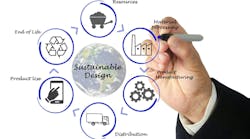Four reasons to hit the gas pedal on sustainable manufacturing
By Tom Nall, global manufacturing and automotive industry director with Avanade
In an economic environment of uncertainty, when manufacturers are reeling from spiraling costs while still facing supply chain challenges, it would be easy to press “pause” on sustainability objectives. Too often I hear clients say this isn’t the time to talk about sustainability, that the focus now has to be on getting product out the door.
But that would be a mistake—and here is why.
Those you count on to help you succeed are watching. We ignore sustainability at our peril. Your stakeholders—customers, employees and prospective employees, partners, Wall Street, government regulatory bodies—care that you are not only manufacturing and distributing products, but that you are doing it as sustainably as possible.
- Customers are increasingly making purchase decisions based on a company’s commitment to sustainable business practices. They want to support companies that are backing up their corporate promises with concrete action. And where people decide to spend their money echoes up and down an entire supply chain.
- The manufacturers I talk with say their inability to attract enough qualified employees is their greatest challenge. Today’s “recruitment wars” are real—building sustainability into the way you do business will help make your company a preferred destination for the next generation of employees. Members of Generation Z, now entering the workforce, are looking for companies that care about the environment. It is a differentiator that can set your company ahead of others.
- In the months and years ahead we likely will see increased government regulation in the area of environmental protection. It is much better to be ahead of the curve. Companies that invest in technology that makes their operations more sustainable also become more efficient, enabling them to meet governmental requirements while achieving greater operational success.
- It’s smart business. Research shows that companies that become more sustainable have a better chance of surviving. They become more efficient. When they deploy digital technologies, they gather actionable data that helps them make better business decisions. And they begin to understand how they can use technology to reimagine whole new ways of manufacturing.
As reported in Shaping the Sustainable Organization, a recent white paper by Accenture Research and the World Economic Forum, nearly 80% of CEOs surveyed said the pandemic has highlighted the need to transition to more sustainable business models.
“Crucially, our analysis shows organizations with stronger sustainability DNA tend to deliver higher financial value and greater environmental and societal impact,” the report said.
The paper continued, “Our analysis shows that leadership teams that build sustainability into the DNA of their organizations are better able to deliver financial value and wider stakeholder impact. In fact, those with the most deeply embedded sustainability management practices outperform peers by 21% on both profitability and positive environmental and societal outcomes.”
Ground-breaking technology is within reach now. Not long ago, the technologies that are making it possible to achieve these new levels of sustainability would have seemed like science fiction. Using extended reality, we can now deploy technicians—virtually—to diagnose and troubleshoot anywhere in the world. We no longer have to put people on planes, creating an unnecessary carbon footprint. We can create truly immersive experiences to onboard and train employees, enable customers to test drive a tractor or conduct a virtual trade show. From the Internet of Things to digital twins and beyond, technologies are available today that are making a tangible difference for manufacturing companies around the world.
My own company experienced this during the early days of the pandemic, when there was a desperate need for ventilators. We participated with other technology companies in the UK Ventilator Challenge, during which we learned we could collaborate, design and manufacture thousands of medically approved ventilators in the space of weeks, not years.
The lessons we learned during that challenge have led to even more innovation that, today, is helping companies operate more efficiently and sustainably. One example: a leading global manufacturer has deployed an intelligent factory-production framework that enables factory managers to see all capacity and output information, allowing them to follow up on efficiency and operations even when they are away from the shop floor. Production metrics are updated in near real time. Service engineers use mixed-reality technology to consult with remote experts to solve technical issues as they arise and to troubleshoot problems at remote locations, negating the need to travel to the site.
Transformative ideas won’t wait. Neither will your competitors. Waiting until a “better time” to improve business sustainability is a competitive risk. The world is advancing fast. Instead of pausing, this is the time to gather ideas from anywhere, both within and beyond your own ecosystem, for how to jumpstart your sustainability initiatives in ways that support your business objectives. What is happening in other economic sectors? What are oil-and-gas companies doing? Logistics companies? What is revolutionizing healthcare that could be reimagined in a manufacturing environment? What ROI are they achieving that can help build the business case for a renewed commitment to sustainable business practices?
It's true: managing meaningful transformation in a time of economic uncertainty is not for the fainthearted. But there are guides available to help you envision how sustainable manufacturing can actually make your business more resilient; consider resources such as peer-to-peer sessions with other company leaders who are wrestling with similar issues, or sessions with technology partners who will actually customize and demonstrate scenarios specific to your situation, enabling you to look before you leap and build a sustainable program that works for you.
Embracing the demand for sustainable manufacturing and the technologies that make it possible enables companies to navigate today’s challenges while positioning themselves to lead in the years ahead.
Now is not the time to pause. It’s time to hit the gas pedal.



